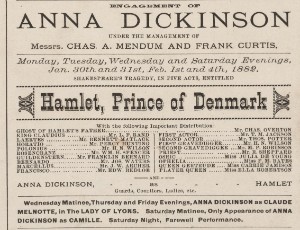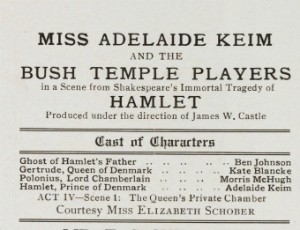In Shakespeare’s day, only men acted in his plays, even playing female characters. 2016 marks the 400th anniversary of the Bard's death, and over the centuries, things have changed. Men and women have played both male and female parts—I even saw an all-female cast of Henry V back in high school.
But that was actually nothing new. In fact, this week is the 134th anniversary of such a performance here in Chicago. On January 30, 1882, Anna Dickinson brought her version of Hamlet to Chicago. (See the playbill in our Digital Collections.) She had given a performance to an enthusiastic audience 10 days prior in Rochester, New York, and received a complimentary review. This must have been encouraging to Chicago critics, who almost a year earlier, in March 1881, offered “An Alarming Report” in the Tribune that “Miss Anna Dickinson seriously purposes to appear on the stage in some of the most exacting male characters of Shakespeare.” However, the critic’s opinion remained unchanged after opening night at McVicker’s Theatre. A letter to the editor printed a few days later claimed the review should “not be allowed to pass unchallenged.” The letter writer pointed out the Chicago audience had received and welcomed Dickinson with six curtain calls that were “not only freely bestowed, but also fairly won.”
Dickinson was not the only woman who took on the role. Charlotte Cushman, Fanny Wallack and Sarah Bernhardt, among others, brought the Danish prince to the stage. Even the “Hardest Worked Woman in Chicago,” Adelaide Keim, tackled the part in 1906, as seen in this playbill.
Do you have a favorite historic Hamlet, male or female? How about contemporary? Explore both for yourself in the Chicago Theater Collection. And find out what's happening in CPL's celebration of Shakespeare 400 and throughout the city at Shakespeare 400 Chicago.




Add a comment to: #TBT: Hamlet, a Woman?